For better or for worse, mixed-breed dogs are becoming more popular by the day. A quick Google search will return thousands of pages devoted to such curious hybrids as the Siberian Husky Pomeranian (the Pomsky!), Chihuahua Dachshund, Corgi Pitbull, Cavalier King Charles Spaniel Shih Tzu, Chow Chow Poodle, and the Shar-pei Pug.
These are by no means the most unusual combinations, as many others will raise a smile – or an eyebrow!
The Chow Chow Pomeranian mix might well do both. It’s super-cute, but you can’t help thinking about that size difference.
If you have questions about the Chowanian, this guide is designed to fill in any gaps in your knowledge. So, read on to discover whether this is the mix dog for you!
While we’re at it, we’ll lift the lid on the world of the mixed-breed dog to examine the positives and negatives.
The first thing to say is that with any new hybrid, there’s a lack of information out there. The best way to discover more is to look at the parent breeds, which is exactly what we’re going to do.
The Chow Chow

Possibly the oldest dog breed around, the Chow Chow has been with us for at least 2,000 years. Because of this, its origins are lost in the mists of time, but they are believed to be a cross between the Tibetan Mastiff and the Samoyed.
Incidentally, the name Chow Chow is not Chinese. In China, they are known as Songshi Quan, meaning puffy lion dog.
However, we do know that they were used as working dogs (hunting, herding, and pulling sleds) in China during the Han dynasty, which ran between 202 BCE and 220 CE.
In terms of temperament, this dog acts more like a cat! He is dignified and aloof, lacking the playful silliness of dogs like the Husky, Corgi, or Springer Spaniel.
He has a real sense of independence, although this won’t stop him from being affectionate towards his family. This independent streak is accompanied by stubbornness. You need to be assertive and firm with him, or he’ll assume that he’s in control!
Most dog breeds are eager to please their owners, the Chow Chow, not so much!
Even so, he is relatively easy to housetrain. Obedience training can be problematic unless you start at a young age. You’ll need to be consistent and prepared to continue this training throughout his life to correct any bad behavior.
He’ll be wary of strangers until you introduce them. Even so, don’t expect him to be overly enthusiastic about having them in the home. He’ll most probably tolerate them rather than greet them with affection.
Another cat-like trait is that they are fussy about being clean, which is no bad thing!
Chow Chows stand between 17 and 20 inches in height and weigh between 45 and 70 pounds. This puts them in the medium-size dog range, although they are strong for their size.
That thick double coat will need brushing at least three times a week and every day during shedding seasons. If you brush it regularly, you can keep down the amount of hair that spreads about your home, as well as stopping any doggie odors.
This dense coat can be blue, red, cinnamon, cream, or black, with no markings. It can be either rough or smooth to the touch.
Three distinguishing features of the Chow are its tongue, tail, and face. Aside from the Shar-Pei, it is the only dog with a black (or purplish) tongue. The tail is covered in long fur and curls over the dog’s back.
As for its face, the Chow Chow always seems to be scowling at you because of its wrinkles.
To finish, this is one loyal pooch. So loyal that it is sometimes too protective, especially when other dogs are around. Because of this, the Chow Chow appears on the list of dangerous dogs. They are even banned in some parts of America!
This problem can be overcome through early, extensive, and continual socialization – it’s just a shame that this advice is so often ignored, leading to this bad reputation as a dangerous dog.
In terms of lifespan, you can expect your Chow Chow to live for between 8 and 12 years. Obviously, owners have a part to play in this, in the way they look after their dog.
Now let’s look at the other parent to see how they compare.
The Pomeranian Dog
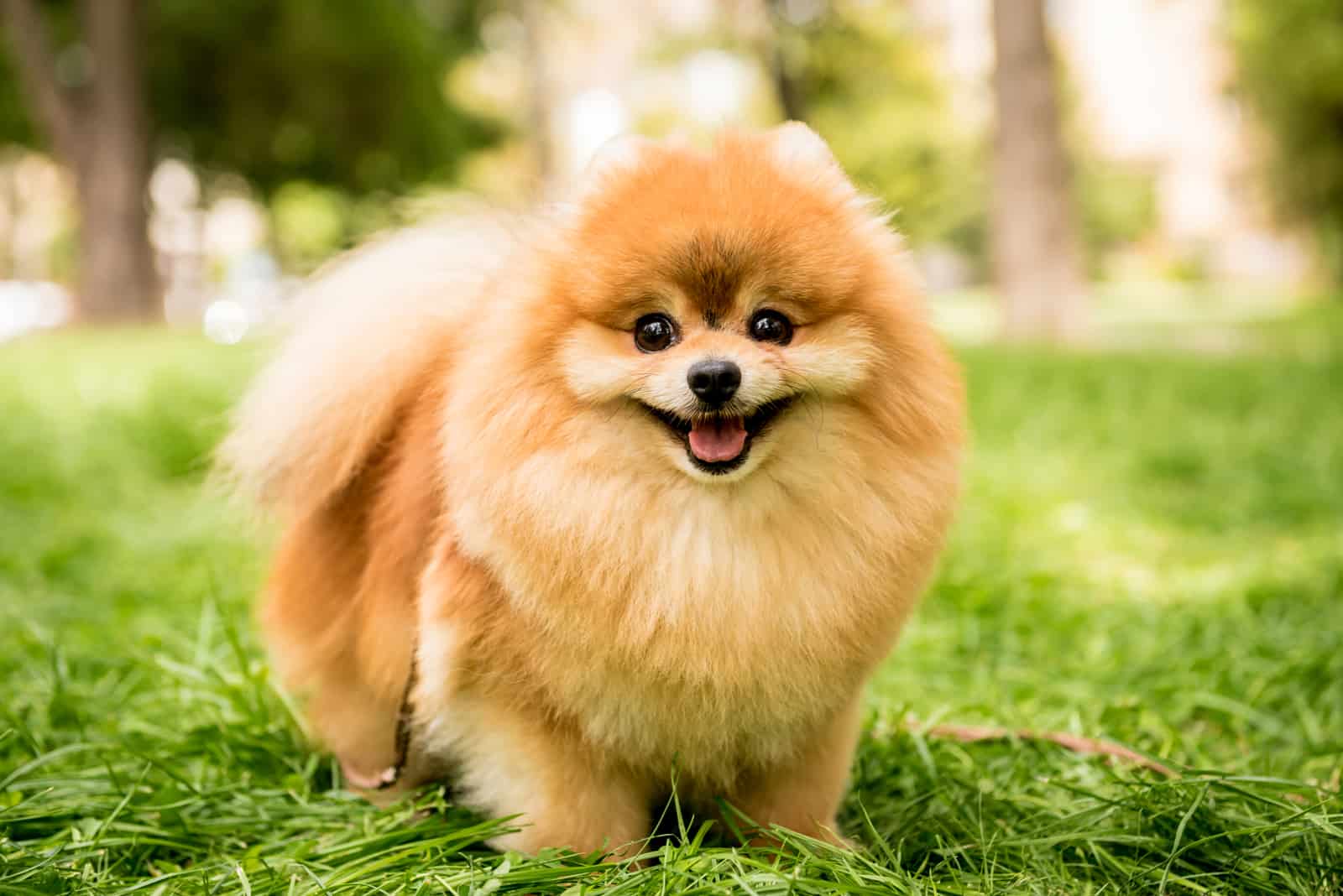
The Pom, as it’s known, is a German Spitz-type breed of dog, meaning that it has long thick fur, pointed triangular ears, and a long, pointed muzzle.
The true origin of these small dogs is not known, but they are associated with the region known as Pomerania, now part of Poland and East Germany. It is believed that they were bred down to their tiny size from their bigger, sled-dog ancestors.
Some say that the smaller Pomeranian owes its popularity to Queen Victoria, who fell for its charms when touring Europe. She is even credited with breeding them down from around 30 pounds to their current ‘toy’ specification. One of her own Poms was a particularly small example, leading to increased demand for tiny dogs.
In terms of temperament, the Pomeranian differs from the ChowChow in that she is extroverted rather than reserved and dignified. She is playful and affectionate, high-spirited, and inquisitive.
She will have her eye on everything and her nose into it at the same time.
She will make a fantastic family pet, but care should be taken if you have small children around. She loves to play but won’t tolerate being pulled about too much and may nip at tiny fingers. It’s natural for kids to think that this cute ball of fluff is a cuddly toy, but it’s a living creature that can easily be hurt if dropped or stepped on.
Like many small dogs, she doesn’t take her size into account and will confront dogs ten times her size. She is also likely to be vocal, barking at everything she thinks is a threat. Both of these behaviors can be addressed through socialization and obedience training. If you teach them to bark on command, they soon learn that constant yapping is not okay. Positive reinforcement and reward-based training are useful here, as your furry friend learns that they get something in return for good behavior.
Current breed standards put the Pomeranian between 6 and 7 inches, weighing between 3 and 7 pounds. That’s a pretty small pooch!
Read More: Pomeranian Growth Chart – How Big Can Pomeranians Get?
Poms also have a thick, straight double-coat, like the Chow Chow, but they are allowed to be any color or pattern, including white, blue, red, black, tan, orange, gray, and brown.
As with most small dogs, they have a longer lifespan, between 12 and 16 years.
Now we’re up to speed with the parents, let’s look at the Chow Chow Pomeranian mix.
The Chowanian
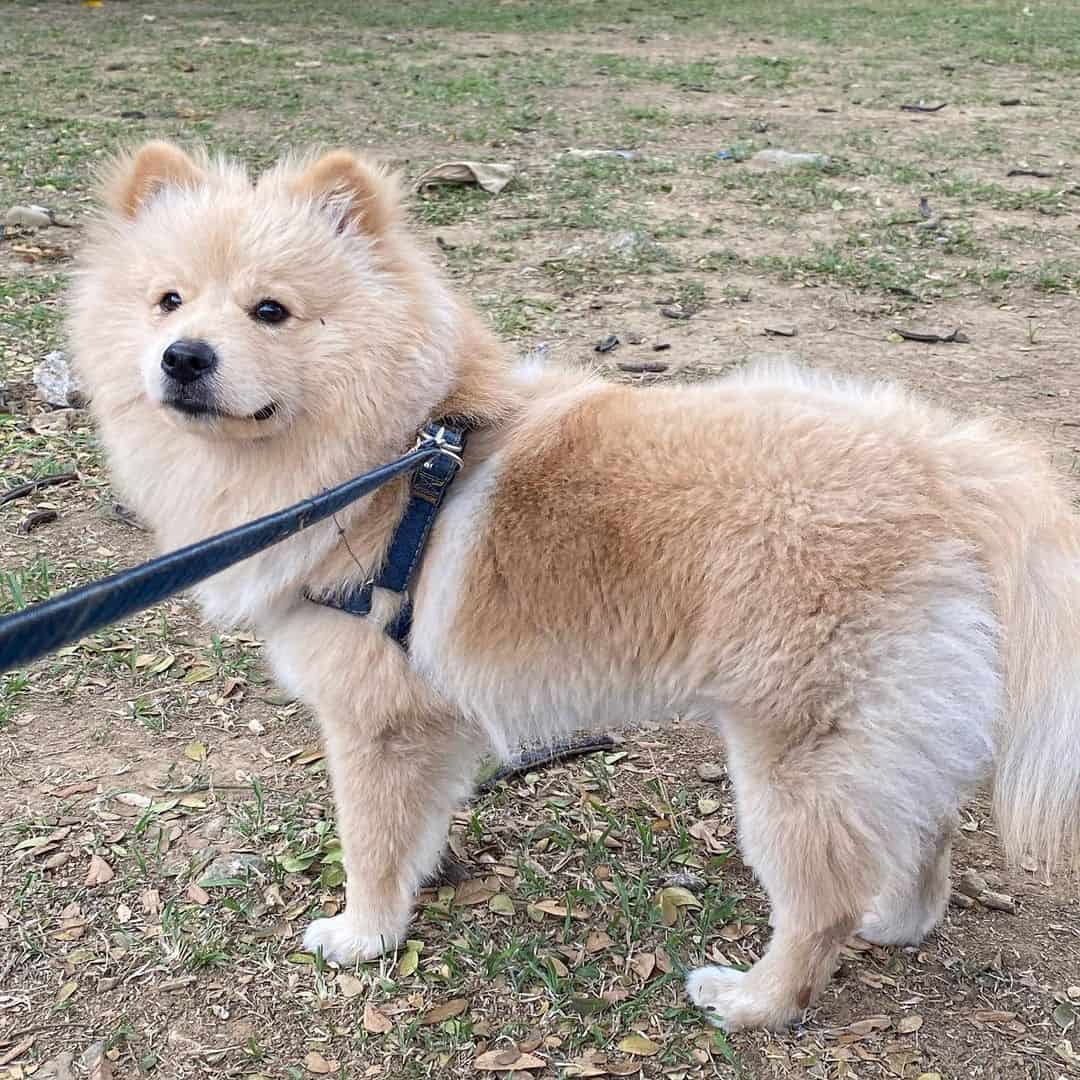
Photo from: @yogiballaspi
Also called the Pomchow or Chowpom, this is an adorable mix breed, bringing together the best bits of the parent breeds.
As we’ve seen, those parents are very different in size, so how does this affect the hybrid?
Usually, hybrids will fall somewhere between the two sizes, although it mostly depends on the dominant genes passed onto the pup. However, the Chow Chow Pomeranian mix is expected to weigh the same as its Pom parent, between 3 and 7 pounds, and to be only slightly bigger, at 7 to 10 inches!
Temperament is always hard to determine, but your Pomeranian Chow puppy is very likely to be an intelligent, high-energy dog with a strong personality.
You’ll need to be assertive and use positive reinforcement to keep the upper hand, or this little dog will assume that they are in control. Once you’ve got that sorted out, get ready for lots of love! Even though they’ll have a sense of independence, they’ll still come to you and other family members for cuddles.
That independent side comes in handy if you need to leave them alone for long periods, as they won’t be too unhappy. However, it’s always best to exercise them well beforehand.
Once they’ve used up a lot of energy, they’ll settle down while you’re away from home. Even so, it’s best to keep a TV or radio on to provide some background noise. This gives them a sense of company and stops them from becoming anxious.
As both parents have long, fluffy coats, your Chowanian is certain to have long hair. Be prepared for a lot of grooming! This coat will need brushing at least every other day to keep the loose hairs under control. You won’t need to bathe them too often as they’re clean dogs. You shouldn’t bathe them too much anyway, as this dries out their skin and causes problems. When you do wash them, only use a branded, high-quality shampoo specific to Poms or Chows.
This dog will have a lot of energy. Long walks each day are vital to its physical and mental health, or your dog may become restless and destructive. Never tether them in a yard, as this is unfair and will result in an unhappy and aggressive dog.
Training should be done in short sessions. They are intelligent dogs who will learn quickly, but they are also strong-willed and need a firm hand.
Get your furry pal to the dog park, doggy daycare, anywhere where there are other puppies! The more you do this, the more relaxed your pooch will be around other dogs. This makes life better for everyone as they mature. Do the same with people, if possible. The more humans they interact with at an early age, the more accepting they will be of strangers when they are fully grown.
Obesity through overfeeding is the number one health concern for dogs in the USA. Speak to your vet to get an idea as to what to feed your pup and how much you should give them each day.
Obesity is dangerous for all dogs, but even more so for small ones. Be sparing with any treats and never be tempted to give them table scraps or human foods.
This is a little dog with a big personality. They’ll make a bigger impression than you might think, for their size. Independent but affectionate, playful and happy, friendly but feisty, and they’ll make an excellent watchdog into the bargain.
It’s a great combination, and you’ll love having them in your home, but they also require hard work on your part to look after them and keep them in check.
As far as we can tell, the Chow Chow Pomeranian mix has a lifespan of between 9 and 13 years. That lower limit is surprising for a small dog, but records are sketchy at best, so these figures may not reflect the truth.
Over time, assuming that this breed’s popularity continues, healthier dogs will be produced – as long as people buy from reputable breeders. We may even see this mixed breed accepted by kennel clubs, giving us better records to study.
All we can say for now is that these are wonderful little dogs who deserve as much love as any other breed.
Chow Chow Pomeranian Mix Price
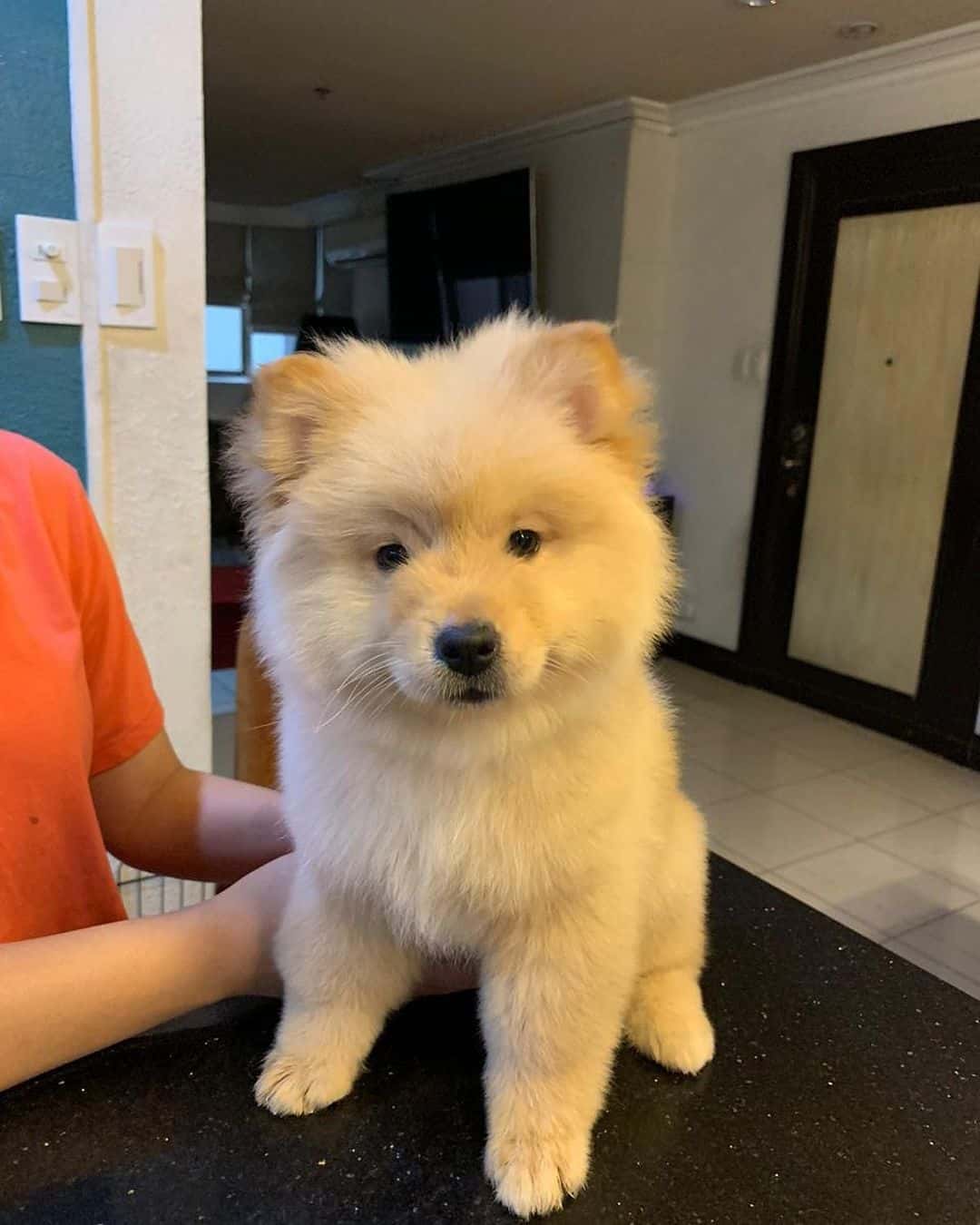
Photo from: @yogiballaspi
Dog prices are notoriously difficult to predict, especially for new breeds. They are influenced by so many factors, including your own location and local demand.
From the information available, we can suggest a figure of between $2,000 and $4,000, but if you’re in the northern states of the USA, then be prepared for higher prices.
This is somewhat justified if the breeder is established and has a good reputation. However, if you find one that has only been operating for a year or two and has Chow Chow Pomeranian mix puppies for sale at a ridiculously high price, then this should serve as a red flag!
Unscrupulous breeders and puppy mills will play on the fact that these are probably the most popular Pom mix in recent times and will push up the price to make more cash. Don’t mistake the hefty price as a guarantee of quality and good health. You’ll recognize a good and reputable breeder when you see one, which is why it’s essential that you visit the breeder in person.
Chow Chow Pomeranian Mix Puppies

Photo from: @yogiballaspi
All puppies are small and vulnerable. They’ll be dependent on you to take the place of their mother once they have left the litter.
This should never happen until they are at least 7 weeks old, and preferably between 8 and 12 weeks. A good breeder will not release them before this time.
Chow Chow Pomeranian mix puppies will be more at risk because of their small size. Puppies are unable to regulate their body temperatures properly, so you will need to make sure they are in a safe, quiet place that isn’t cold or draughty.
A reputable breeder will have begun the weaning process by the time you take the pups home, and you need to continue this. Bear in mind that you’ll also have to contend with the teething process, so make sure you have plenty of chew toys to hand!
Nurturing a puppy through its early days is a rewarding experience and will bring you equal amounts of joy and frustration. The key to your success is to be fully prepared for all eventualities.
Make a list of all the things you need to buy and plan ahead for things like training sessions and visits to the vet.
Above all, budget for any expenses, as you will be spending around $150 per month to keep a small dog.
Full Grown Chow Chow Pomeranian Mix
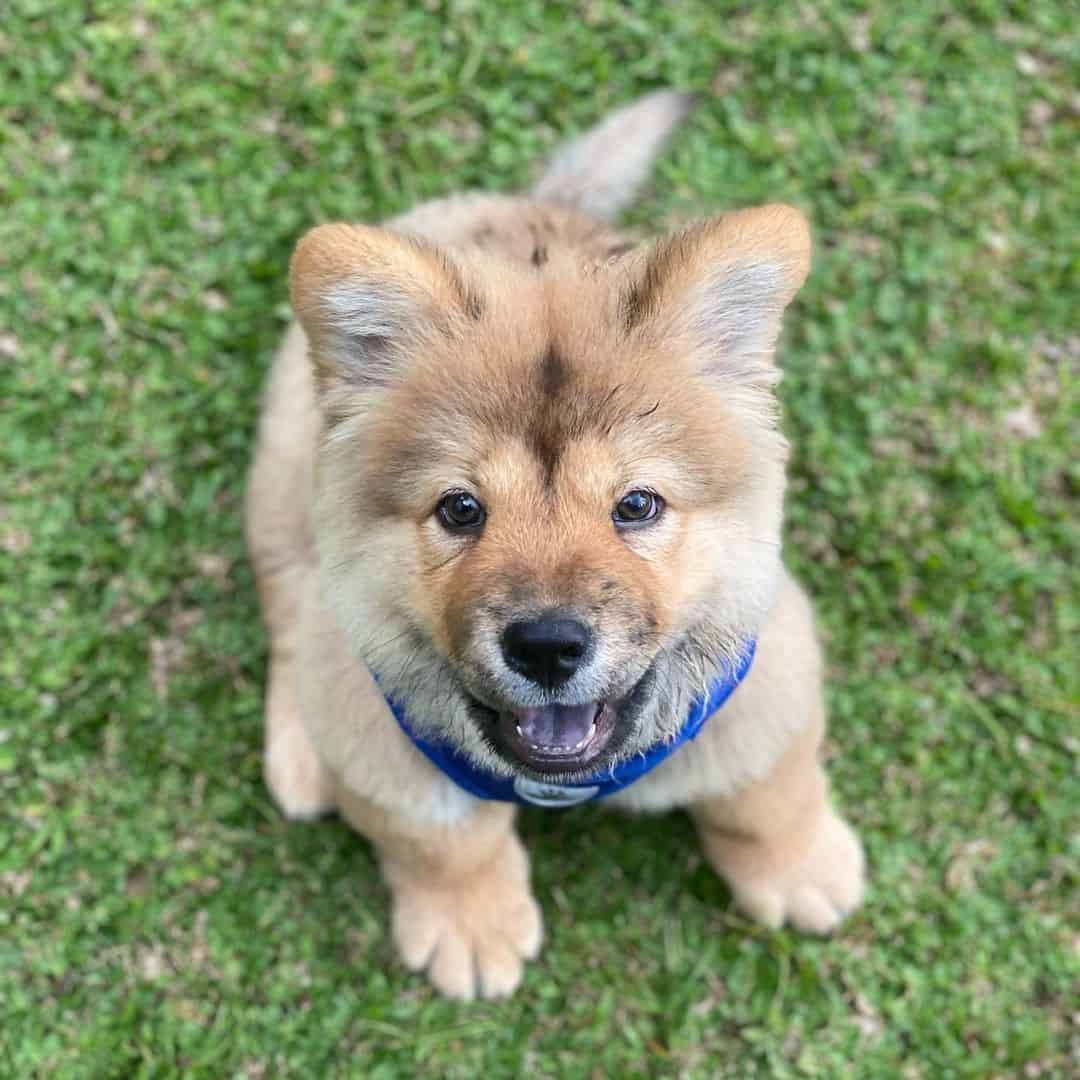
Photo from: @guccishiro_fabdoggies
Even when they are fully grown, your Chowanian isn’t going to take up much room. The biggest they will get is around 10 inches and weigh about 7 pounds. There is a small chance that they’ll get bigger, depending on the genes they inherit, but it probably won’t be much.
If you wonder just how big these pups can get, you can always check out the Chow Chow weight chart, as this will give you an idea of the upper limit these doggies can reach.
This makes these wonderful dogs ideal for most living spaces, including apartments. These dogs are fairly adaptable and will fit into your lifestyle without too much trouble.
The main thing is to make sure they get enough exercise, whether you’re in a town or the country. Dog parks are ideal, but if you have a large backyard where they can let off steam, all the better.
Getting them safely through the puppy stage is one thing, but your work doesn’t end when they mature. Your job is to keep them healthy by giving them love, exercise, a good diet, and grooming.
As well as brushing them regularly, check their ears and eyes for any signs of infection, and clip their nails frequently.
If you bought your pup from a good breeder, the chances are that it will be generally healthy. You still need to book them in for health checks at the vet every few months, just to be on the safe side.
With the right diet, exercise, and grooming routine, proper training and socialization, and a little bit of luck, your Chow Chow Pomeranian mix will bring you love, fun, and enjoyment for 13 years or more.
Mini Chow Chow Pomeranian Mix
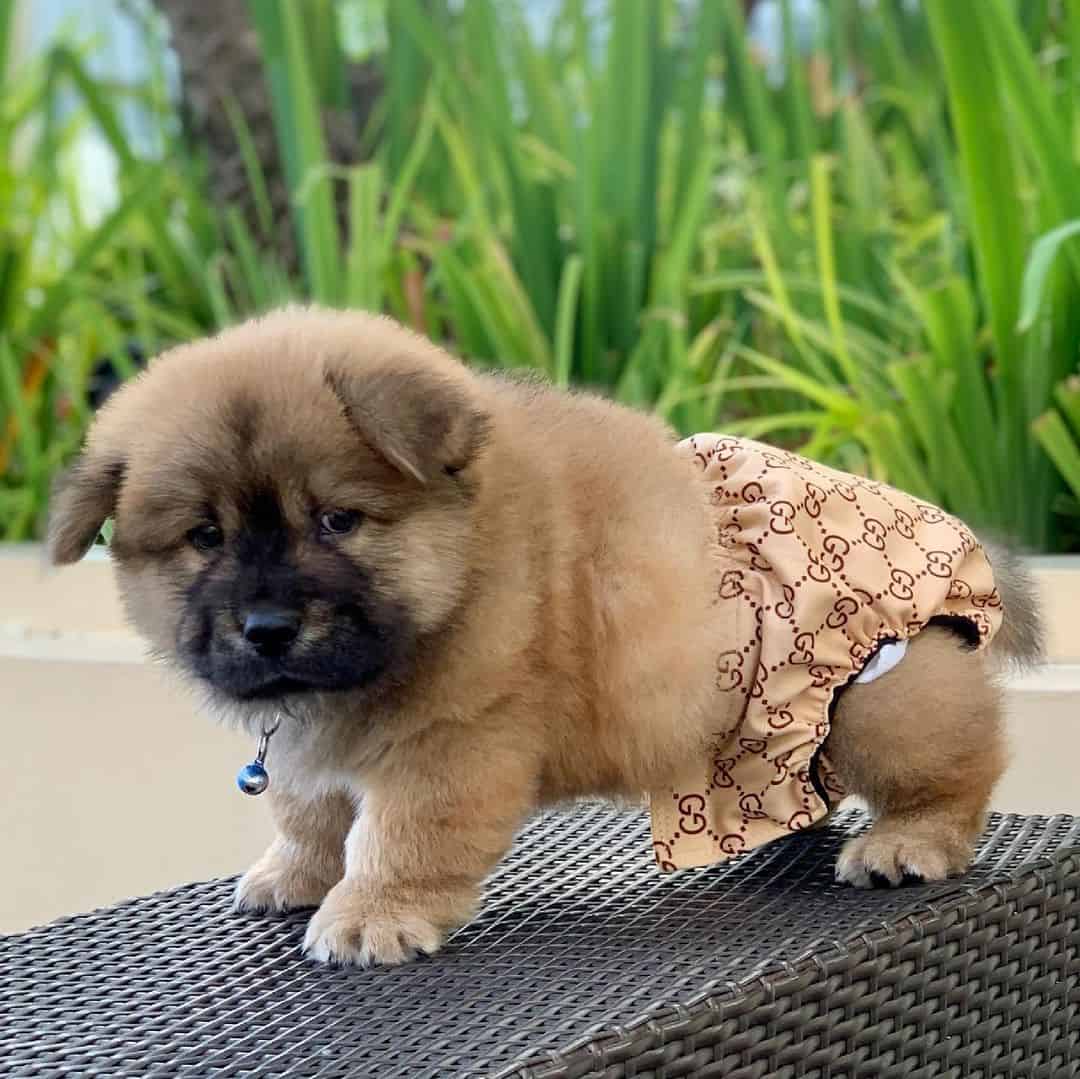
Photo from: @guccishiro_fabdoggies
Now, you’re probably thinking something like…
This dog is small enough already, so surely there’s not a miniature version?
And you’d be right. You can get miniature Chow Chows, but a mini Chow Chow Pomeranian mix is unlikely.
If you come across anyone claiming that they had a teacup version for sale, be very cautious! The Chowanian is already classed as a toy breed, and to go much smaller would compromise their health.
Also, some breeders use cruel methods to achieve this, such as deliberately withholding nutrition from puppies to stunt their growth. They also introduce the dwarfism gene, which can cause congenital disabilities and many other health problems.
Always avoid breeders who use the term teacup as a selling point, suggesting that it is a specific breed. The dog has to be under 5 pounds to class as a teacup, which many of these dogs are already.
Health Issues Of The Chow Chow Pomeranian Mix

Photo from: @yogiballaspi
Like all dogs, the Chow Chow Pomeranian mix has a few health issues to consider. The problem with new hybrids is that there isn’t enough data yet to build a clear picture of what these health issues are.
As we already pointed out, some mixed breed dogs don’t inherit genetic health problems from their parents.
However, it is wise to be aware of any potential diseases or health conditions that the parent dogs have so that we can be prepared in case the mixed dog pups show the same symptoms.
With this in mind, here are some of the more common conditions found in Pomeranians and Chow Chows:
Patellar luxation – The patella (kneecap) slips out of place, often making the dog yelp in pain.
Hip dysplasia – The result of a malformed hip joint, making the bones rub together.
Elbow dysplasia – A similar condition to the one above, but affecting the elbow joint.
Entropion – The eyelid turns inward, making the hairs scrape against the cornea.
Thyroid problems – Usually in the form of hypothyroidism, where the thyroid gland is underactive and doesn’t produce enough of the hormones needed for the dog’s metabolism to function properly.
Collapsing trachea – A weakening of the cartilage in the trachea (windpipe) sometimes causes them to flatten and eventually collapse. This is a progressive disease that can be fatal if the trachea becomes completely blocked off.
Seizures – Epilepsy is common in many dog breeds, but the cause is often unknown. Symptoms can be mild to severe but are mostly managed through medication.
Congestive heart failure – This is not a disease itself but a result of heart disease*. Congestive heart failure occurs when the heart is unable to pump enough blood around the body. The extra pressure causes fluid to build in and around the lungs, stopping them from inflating fully and preventing oxygen from getting into the blood supply. This causes a whole range of other health issues.
Alopecia X – Found on the Pomeranian side, this is also known as black skin disease. It is a genetic disease that causes the skin to turn black and for all the hair to fall out. Thankfully, it is a very rare condition!
It’s interesting to note that these are the health conditions for purebred dogs and won’t necessarily be seen in the Chow Chow Pomeranian mix
To have the best chance of getting a healthy mixed breed dog, it is vital that you only use reputable breeders.
Alternatively, contact organizations such as PomRescue, as they may be able to put you in touch with trustworthy people or let you know if there are any rescue Pomchows that need a home.
*Tragically, around 75% of all senior dogs have some kind of heart disease. Only around 5% of these cases are congenital (inherited from the parents) and most are the result of things like heartworm, parvovirus, nutritional deficiency, or hypothyroidism.
Are Mixed Breeds Ethical?

Some people call them hybrids or mixed breed dogs. Others call them mutts, which is only a short step from cur. Both of these words have negative associations and tend to be used by those who favor purebred dogs.
These people frown on the rising popularity of designer dogs, claiming that it is unethical and causes health problems. They worry that the gene pools of traditional breeds will be ‘polluted’ or that those breeds may become extinct.
When it comes to health, they may have a point. Traditional breeds have been produced through decades of trial and error, resulting in the dogs we recognize today. Reputable breeders strive to keep these dogs as pure as possible, screening for health issues.
Experienced breeders know what to expect when they put two Labradors or German Shepherds together. Within reason, they can determine what the coat colors will be, and to an extent, the temperament and character.
Mixed breed dogs are much more unpredictable, especially in the hands of inexperienced or unethical breeders. The sudden interest in designer dogs has encouraged puppy mills to cash in on the trend. They have little concern for their dogs, and most have a reputation for keeping them in bad unsanitary conditions. Their main aim is to make as much money as possible.
Those in favor of mixed breeds point out that it injects fresh genes into the mix, making healthier dogs. This is true, to some extent. Many hybrids, especially second-generation ones, avoid some of the genetic flaws of their parents. But it can just as easily result in some unexpected and unwanted traits.
Does this mean that you should avoid mixed breeds and that purebred dogs are produced ethically?
Well, no, and no!
It’s important to remember that all purebred dogs were once mixed breeds. There are good breeders and bad breeders. And even with the best intentions, many breeds suffer because humans want them to be a particular shape or size.
Methods such as line breeding and inbreeding are used to do this, which can result in some very undesirable traits.
Take brachycephalic breeds, for example, such as Pugs, Bulldogs, Shih Tzus, and Cavalier King Charles Spaniels. They have been bred to have flat faces and completely lack the long snout most other breeds have. This feature was deliberately bred into them by humans, originally as an aid to fighting and hunting. These days, it’s kept simply because people like the look.
The problem is, brachycephalic dogs are unable to regulate their body temperature and can easily overheat. They also have breathing difficulties (called brachycephalic obstructive airway syndrome), eye diseases, dental problems, and are unable to mate or give birth naturally.
This is just one single example among many.
So, what’s the answer?
Unfortunately, there isn’t an easy one. It all comes down to the knowledge, skill, and experience of the individual breeder. It also depends on your own opinion and whether you trust the breeder in question.
Whatever you believe, there is no doubt that certain types of dogs suffer because of breed standards laid down by kennel clubs. Does this mean that we allow them to become extinct? Well, that’s for others to decide!
As always, the key point is that you should only ever buy a dog from a reputable breeder who you know you can trust.
Read Next: 26 Pomeranian Mixes: Too Cute To Handle















